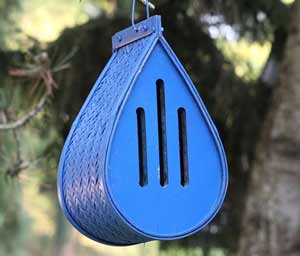Hibernation Boxes: Do They Work?
by Claire Hagen Dole
What is a Hibernation Box?
 Have you been tempted to buy a butterfly hibernation box? These decorative
wooden boxes, which look like tall bird houses with slit openings, are marketed
by nature stores and bird outlets. But do they work?
Have you been tempted to buy a butterfly hibernation box? These decorative
wooden boxes, which look like tall bird houses with slit openings, are marketed
by nature stores and bird outlets. But do they work?
First, let's be clear about what they're designed to do. Unlike birds, butterflies don't require a sheltered space to rear young. Their caterpillar "babies" feed themselves, munching on leaves and buds, and perhaps constructing a leaf shelter for safety. Adult butterflies looking for shelter from rain or darkness will perch under a leaf or against the bark of a tree.
In temperate climates, butterflies spend the winter months in diapause (hibernation). They've all evolved to wait out the cold months during one developmental stage--as egg, larva (caterpillar), pupa (chrysalis) or adult. It's most common to hibernate as larva or pupa, but a few species (notably anglewings and tortoise-shells) overwinter as adults. Examples are Mourning Cloak, Comma, Question Mark, Milbert's Tortoiseshell and American Snout.
These butterflies hide under tree bark, in a wood pile or in the rafters of an unheated garage. A warm winter day may bring them out to bask in the sun and to take nourishment from tree sap. Hibernation boxes are designed to offer a dry, sheltered place for them to spend the winter.
Marketing Confusion
So what's the reason for the sudden popularity of hibernation boxes, given the insects' ability to manage on their own? The boxes are ornamental additions to a butterfly garden, which may be particularly attractive to a beginning wildlife gardener.
What information is such a beginner getting at the marketplace? I called three local stores of a bird-oriented franchise and got these responses to my questions about butterfly boxes:
- "It's a roosting box. Butterflies can hang out and use them however they choose." Comment: sounded young and was improvising.
- "The box offers a roosting situation. Put it near red or yellow flowers." Comment: also improvising. Boxes are designed for overwintering adults in diapause.
- "It's a hibernation box for winter or summer. Put in a warm, sunny area so butterflies can get out of the elements. Likely users are Monarchs and angelwings [sic]." Comment: was reading from box insert. Don't put in the sun because inside will get too hot. Monarchs overwinter in trees of Mexico or California. Correct term is anglewing, which describes the angled wing edges.
Taken aback by this misinformation, I called a friend who works at a similar store. She's seen a lot of people respond to the looks of a rustic birdhouse or butterfly box, and she takes the chance to educate them about habitat needs of wildlife. Would she sell a hibernation box? "As an ornament, but I'd try to steer them toward a more useful item like a butterfly gardening book."
Build a Box - or a Woodpile
It's not difficult to construct a hibernation box, should you wish to test one in your garden. The box can be about two feet tall by a few inches wide/deep. A slanted roof protects the box from rain; a hinged door for cleaning is optional. Narrow entrance slits keep out predators like birds and mice. Inside, place a piece of rough bark where the butterfly can perch.
Put the box in a lightly shaded spot, several feet off the ground. Nearby larval host plants, such as nettles, elm and willow may attract potential users.
Three woodworking plans appear in Beastly Abodes by Bobbe Needham (Sterling Publishing Co., 1996), a book devoted to birds, bats, and other creatures. Boxes are adorned with bark or twigs.
In Butterfly Gardening for the South (Taylor Publishing Co., 1990), Geyata Ajilvsgi suggests tacking pieces of bark or rough boards against a fence or building. Leave a narrow crack on one side, where the butterfly can wedge itself inside.
You can also make a woodpile for butterflies and other wildlife like spiders, beetles, mice and snakes.
In Wings (spring 1990), Bernard S. Jackson describes a log pile he constructed for overwintering adult butterflies and for pupating larvae at the Memorial University Botanical Garden, St. John's, Newfoundland. He stacked six-foot logs in layers at right angles to each other, leaving a few inches between pieces. He then nailed roofing felt to the top layer for waterproofing.
Around the woodpile, Jackson set both nectar and larval plants to soften its look and to draw in butterflies. He points out that a smaller woodpile, built in the same style, would work in a backyard setting. (Wings is published twice a year by Xerces Society, 4828 SE Hawthorne Blvd., Portland, OR 97215; $25/yr.)
Hedgerows and Hibernation Boxes
A woodworking plan that appeared in Birds & Blooms (send SASE to BGQ for copy) was used as part of a Cub Scout service project in Sterling, Virginia (a suburb of Washington, D.C.). Scouts built seven boxes for the Hedgerow Habitat Trail at Community Lutheran Church in fall, 1995. They substituted a plexiglas panel on one side so boxes' use could be monitored. Boxes were sited in a wooded area. Says trail organizer Suse Greenstone, "We've checked the boxes in spring and fall since they were put in. So far, no butterflies, but spiders love them!"
The Hedgerow Habitat Trail includes meadow, wetland, hedgerow, woodland, and rock pile for amphibians. A regional native plant symposium was held in fall 1997 at the church.
Forty in Pennsylvania
At the same time, a more ambitious hibernation box project was taking place at Shaver's Creek Environmental Center, Penn State University. Eagle Scout David Wisniewski constructed 40 boxes for PSU's Department of Entomology. The boxes were attached to trees along woodland trails of Shaver's Creek, where Mourning Cloaks and other overwintering butterflies are commonly seen.
On a sunny day in March, 1996, boxes were inspected for occupancy. Spider silk was found in eight boxes. The following March, a second inspection turned up greater evidence of use by various creatures: 26 of the boxes contained spider webs and silk; seven contained abandoned nests of umbrella wasps; three had overwintering cluster flies; two had been used by pupating Gypsy Moths; one had a colony of ants; two had dead stink bugs; and one contained a nest of black locust leaves left by one tiny white-footed mouse. Eight boxes were empty.
Says Robert Snetsinger of PSU, "I have yet to see evidence to support the notion that butterflies actually need or use butterfly houses. My suggestion is, if you want to do something useful for butterflies, build them a mud puddle." (Reported in Butterfly Times, Dept. of Entomology, 501 ASI Building, PSU, University Park, PA 16802.)
NABA's News
Finally, the North American Butterfly Association put out a request for member feedback on hibernation box use. Only three responses came in; all were negative (unless you count usage by wasps and spiders). Commented one member, "We have lots of trees and several small buildings for butterflies to hibernate in; maybe they just don't need my box!"
NABA's Ann Swengel comments that "expectations need to be realistic about such boxes. Most bird boxes get used by something, because there are so many kinds of birds that might use them. I think we should look at butterfly boxes as more like bat houses: these require more specific conditions and locations and still some luck to get occupied by the targeted animal."
A Natural Surprise
I was reminded this summer of the resourcefulness of caterpillars and butterflies, when I began preparing our house for painting. I removed a basket, which was fastened to the porch next to the mailbox. There, behind the basket, an empty swallowtail chrysalis was attached to the wood siding. How I wish I had been on the porch a few weeks earlier, when the Western Tiger Swallowtail emerged!
Should something like a pupation box be developed and marketed, I doubt I'd be interested. I'll take a surprise discovery, in my yard or along a mountain trail, anytime.
Article by Claire Hagen Dole, Publisher/editor of Butterfly Gardeners' Quarterly. #10, Fall 1997.
If you'd like to build your own butterfly house, click here for butterfly house plans.



